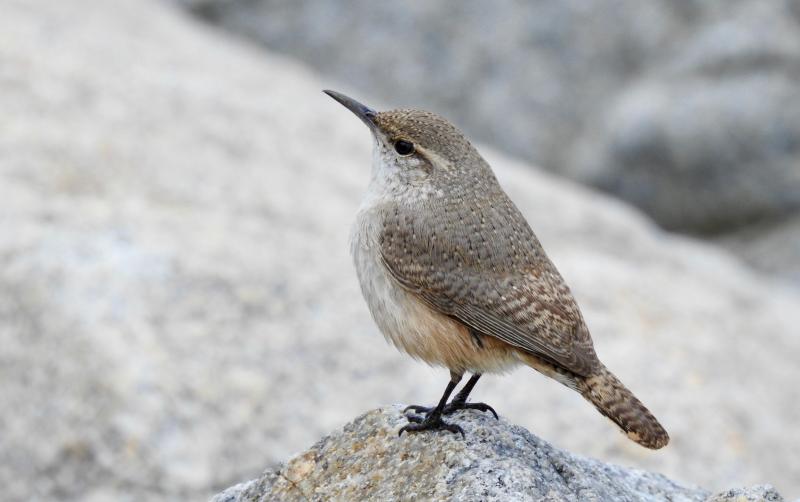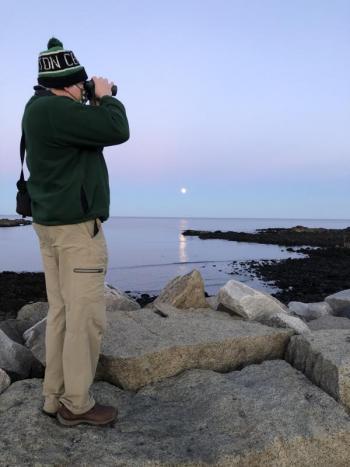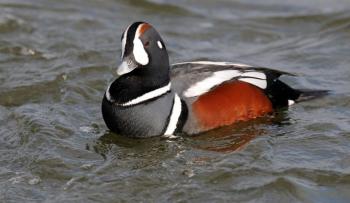It’s a familiar story. Rare bird shows up. Birders finally find a break in the work and home schedule to go look for it. Arrive just in time to hear that it has not been seen for several hours. Search diligently in the waning light and growing chill of an early winter late afternoon. Bird is nowhere to be seen. Darkness falls and said birders make the long drive home not knowing whether the bird will stay and, even if it does, if they will have the chance to look for it again.
That was our story late on Sunday afternoon when we drove to Ogunquit in the hopes of catching at least a glimpse of a that’s rare to Maine, a rock wren. The rock wren is really a bird of the western part of the continent, breeding from southwestern Canada south to Mexico and Central America. The closest it normally gets to us is western North and South Dakota—about 1,500 miles away.
But rock wrens in the northern part of their range migrate south, and because of that, occasionally individuals get off-course and end up in places where birders get very excited to see them—places like Maine. A rock wren had been seen and described over in Trescott, Maine, back in October of 2013. It was the first and, up to a few days ago, the only record for the state. There are a few records from other states in the Northeast but not many. Rock wrens don’t show up our way very often, or at least they are not detected if they do.
So it was a great surprise when, on November 27, a birder noticed a bird hopping on the rocks outside a restaurant at Perkins Cove, in Ogunquit, and snapped a photo. That bird turned out to be a rock wren doing what they do best—hopping around and snatching up insects among the massive rocks that make up the berm protecting the parking lot there from winter storms. In its western range, such rocky places are usually in the mountains and canyons. The best substitute this wayward bird could find was the jumbled stones behind the rocky beach at Perkins Cove.
Many birders saw this perky little black-legged wren on Saturday as it hopped about, occasionally showing off the deep-knee bends it is known for and obliging admiring birders with close approaches and marvelous views. Some birders reported that the wren was still visible even as late in the afternoon on Saturday as 4:15. Photo opportunities apparently abounded and continued into Sunday morning.
We couldn’t get away until mid-Sunday afternoon but, buoyed by the news of the birds late-afternoon behavior the day before, we struck out anyway, with our teenage son in tow, even.
It was not a good sign when, upon arrival, there was a multitude of parking spaces available in the rather limited parking area at Perkins Cove. Only one other birder was in sight, and he was clearly searching for but not seeing the wren. The bird had not been seen for at least an hour, he told us when we caught up with him, but it has been there all day, he had been told.
We scanned and walked and listened. No wren.
The moon rose over the sea, illuminating a silver streak across the calm, dark water. As our eyes followed the moonlight, we noticed some small ducks in the cove. Five incredibly gorgeous harlequin ducks bobbed just a hundred yards from shore beside the rocky ledges. We had been so focused on looking for the wren that we had almost missed the amazing scene right in front of us.
No, we did not see the rock wren. But we left fulfilled and content thanks to some harlequin ducks in gorgeous Maine coast moonlight.
Jeffrey V. Wells, Ph.D., is a Fellow of the Cornell Lab of Ornithology and Vice President of Boreal Conservation for National Audubon. Dr. Wells is one of the nation's leading bird experts and conservation biologists and author of the “Birder’s Conservation Handbook.” His grandfather, the late John Chase, was a columnist for the Boothbay Register for many years. Allison Childs Wells, formerly of the Cornell Lab of Ornithology, is a senior director at the Natural Resources Council of Maine, a nonprofit membership organization working statewide to protect the nature of Maine. Both are widely published natural history writers and are the authors of the popular book, “Maine’s Favorite Birds” (Tilbury House) and “Birds of Aruba, Bonaire, and Curaçao: A Site and Field Guide,” (Cornell University Press).
























